Writing impactful fundraising letters can be hard. That’s why we created these templates, along with examples for every sector!
Scroll down to take a look at our fundraising letter examples, templates, and donation forms. You can tailor these example fundraising letters to your own fundraising campaigns.
For additional help with your nonprofit fundraising, check out: How To Write The Perfect Fundraising Letter (With Templates)
Introduction
Many nonprofit organizations have given up on the idea of sending appeal letters, believing that direct mail fundraising campaigns are expensive. But this is far from true!
A recent Direct Marketing Association study noted the average response rates of direct mail campaigns is at 4.4%. That’s 37 times higher than the average email marketing rate of 0.12%.
While asking for sponsorships via donation letters is definitely more expensive than email, the trick is to do this strategically. Develop a fundraising goal, segment potential sponsors, and send donation request letters to a targeted group that are likely to give.
Do that and watch the donations roll in!
We wanted to help by providing sample fundraising letter templates, and donation request letters for every nonprofit organization. We’ve got example fundraising letters from animal shelters and education to gift fundraising, so you can get a head start drafting your own.
Why write nonprofit fundraising letters?
Consider the fact that 34% of the population in the US is over 50. Most people in this age group prefer receiving donation request letters over email — in fact, many don’t even have an email account!
By neglecting to write donation request letters — you’re leaving out a large segment of potential donors. A segment that’s more likely to give major gifts, make larger contributions, and help you meet your organization’s financial needs.
To build a sustainable nonprofit organization, it’s important to have diverse sources of funding. Fundraising appeal letters can help you reach out to community members that don’t visit donation pages or respond to online fundraising appeals.
Your donation letter templates don’t always have to be for older community members — sending general donation letters to a younger audience has a personal appeal and differentiates you from other nonprofits sticking to online fundraising.
A well-designed direct mail campaign could excite younger audiences enough to support your cause.
Donation request letters can appeal to a wide variety of audiences, foster personal connections, and build a supportive and engaged list of potential donors.
Who wouldn’t want that?
What if creating fundraising template letters are too expensive for my organization?
Here’s the real problem: the budget.
If you’re running a small nonprofit organization with limited or stretched budgets, pitching a donation request letter campaign can be tough.
When placed alongside the obviously quick, inexpensive and easily tracked option of online fundraising, making a case for fundraising appeal letters or direct mail sponsorship requests approaches the impossible. Pricing can be quite high (you have to pay for paper, design, printing and outreach), time-consuming, and can be difficult to track ROI.
These concerns are legitimate – some nonprofits may be better off focusing on online donations and leaving out fundraising appeal letters. But many dismiss the idea without giving it proper thought. This needs to change.
Direct mail campaigns continue to generate a significant part of donations. Dismissing the medium in your fundraising strategy could cut you off from a great source of revenue.
Follow these steps to make your campaigns work for you:
If you believe you don’t have the budget — start small. You don’t need to send donation request letters to everyone. If this is a first-time campaign, compile a list of your biggest donors, or donors that have been giving regularly for a long time.(A CRM or donor management software can make this easy!) Send one or both groups a sponsorship letter. You can even set a cut-off donation amount and send letters to donors who have given above this amount.
Experiment with donation request letters — If you’ve never done this before, you might not want to invest a large amount in a fundraising appeal letter campaign. Create a pricing plan for the campaign – and select the number of donors based on this. If your fundraising campaign is successful, you can increase your budget and make letters a regular part of your organization’s fundraising efforts.
Develop a fundraising strategy for sending direct mail – There’s nothing more wasteful than a badly planned (or worse, unplanned) campaign. If pricing is high, make sure you spend enough time planning and developing your templates so you spend wisely. Sending an ad hoc campaign at the last minute might not get you the results you expected, and you might end up falsely putting the blame on the medium rather than the campaign. If your budgets are tight, nothing saves time, money and resources like a robust fundraising strategy and plan.
By starting small, setting aside limited budgets and planning well in advance, you can still manage to build a decent revenue source from sponsorship letters (and reach potential donors that you hadn’t before!).
How do I know if fundraising appeal letters are a good fit for my nonprofit?
Write fundraising letters if:
- You’re looking to expand your donor base
- You need more fundraising ideas to engage your donors
- Many your donors are over 50 years old
- You have the time and resources (including staff) to strategically design and execute a campaign
They may not be a good fit if:
- Most of your donors use online fundraising
- You’re already receiving significant amounts from other fundraising events (like corporate donations or matching gift campaigns)
- You have limited resources and no time to plan a separate campaign because of upcoming events
- Most of your donors are under 50 and you don’t have the time to develop a fundraising strategy to cultivate more diverse donors
When should you send donation request letters?
If there’s one thing to take away When it comes to sending sponsorship letters, it’s this: don’t spam potential donors with all of your fundraising initiatives.
Sending letters weekly or monthly isn’t just cost-intensive — it’s also damaging to your donor relationships. Constantly receiving fundraising donation letters from an organization will either annoy people or make them ignore your initiatives.
Instead, think strategically about when you want to send letters — and don’t send them more than 3–4 times a year. For example, you can send letters to announce important fundraising events like calls for in-kind donations, end of the year campaigns or any important fundraising efforts that’ll grab a reader’s attention.
You can also send donation updates or follow up thank-you letters to a few donors, but avoid anything more than this.
Sending fewer sponsorship letters with a strong call to action will make sure people read them.
You can work on developing example fundraising letters and templates earlier in the year, but send them during Christmas, Giving Tuesday or at the end of the year (between September–December). This is when local businesses and family members are primed to donate and you’re more likely to receive a positive response. You can also experiment with a few less popular holidays or days that are meaningful to your organization alone — for example, if you’re an environmental organization, try sending a fundraising appeal letter on World Wildlife Day.
The best fundraising letters are planned strategically for select gift programs or annual funds, sent to a few potential donors and don’t spam the audience.
Tips on sending fundraising appeal letters
Make sure you have a fundraising strategy: We’re saying this again because it’s important — don’t create fundraising template letters to send at random times. You may still get great results, but planning helps you track your fundraising efforts, be consistent and understand what went wrong. Without a good plan, even if your campaign goes well, you won’t know what made it work!
Personalize, personalize, personalize: We can’t say this enough! Sending a personal donation letter appeal can really help boost your campaign. Instead of generic salutations like ‘Dear friend,’ personalize your letters with a written salutation that includes your donor’s name. Don’t just include your organization’s name at the end — use a real signature (instead of a printed or stamped one). This will make potential donors feel valued as important partners in your mission. Creating a fundraising template letter with a handwritten note, at a time when everything is printed is a special way to thank and acknowledge a donor’s valuable contribution.
Don’t over-design your email: Extremely polished designs (including color-printed envelopes) can backfire by making your letter seem like junk mail. Instead, use plain paper and hand-write the address if possible — if you still want to stand out, try using a non-standard envelope size or a differently colored envelope and make sure you include your organization’s name. It’s simple, personal, and will grab the reader’s attention without seeming like junk mail.
Be clear about what you want: your sample fundraising letter should include a clear call to action and ideally be based on donations made in the last year. Pulling at a donor’s heartstrings and then asking for vague support leaves donors confused and unsure about what to do next. If they’ve reached the point where they’ve opened and read your donation request letter, give them something to do! Be careful about including amounts that are too high or too low — if you’re using a donation management platform like Sumac Donations, you can segment your donor lists according to donation amounts and include different asks for different donors. Besides money, you can also ask for in-kind donations, auction items, local business sponsorships, social media follows or invite them to attend upcoming events! Whatever you choose, make sure your ask is something that’ll meet your organization’s needs.
How to use these fundraising letter templates
These sample fundraising letters are a good starting point and will give you a clear picture of all the information to include. Copy these example fundraising letter templates into your own document and change the information (and language) to suit your own organization’s needs.
Using these example fundraising letters means you won’t miss out on any important information (like proper salutations, phone numbers, and important donation details) – but don’t forget to make it your own! Remember, different types of fundraising letters will have different calls to action. A school fundraising letter will use a different tone from a church fundraising letter or a sponsorship request for a mission trip.
After writing your example of a fundraising letter – send it to your design team and others in your organization for their feedback. If you want to create effective fundraising letters, you’ll want to get as much feedback as possible to make it perfect.
Fundraising letter templates that work:
We’ve written a few types of fundraising letters to get you started!
You can navigate to the sample fundraising letter most relevant to your organization’s needs by clicking on the tabs to your right.
- Animal Rights donation request letter
- Shelters fundraising template letter
- Wildlife Protection sample fundraising letter
- Children’s charities fundraising template letter
- Disease and disorder charities fundraising letter example
- Education letter sample
- Women’s charities fundraising appeal letter
- Fine Arts and Culture sample letter
- Food Bank fundraising letter example
- Health & Fitness Services fundraising letter template
- Hospital and Medical Centres letter template
- Medical research fundraising letter template
- Public and social service fundraising donation letter
- Humane Services example fundraising letter
- International Charities fundraising letter template
Asking for donations has never been easier with these sample fundraising letter templates! Feel free to customize them for your own organization’s needs.
Animal Rights Fundraising Letter Template & Example
Fundraising Letter Template
At the Toronto Humane Society we’re always looking for ways to reduce the number of abandoned animals. And, our new spay/neuter service is making a big dent in the feral cat population – it’s estimated that between 100,000 and 300,000 feral cats are already calling our city home. With spring around the corner, this number will vastly increase! And, no one wants to see these poor kittens roaming our city, hurt, hungry and scavenging for scraps of food.
Sometimes, just like the animals in our care, we feel abandoned too.
We receive no outside funding… no municipal, federal or provincial grants. We count solely on the generosity of people like you — people who believe that every animal and pet has a right to love and be loved.
And that’s why we need you back. More and more cats and dogs, bunnies and budgies, turtles and gerbils are counting on us.
You are the animals’ guardian angel.
Your thoughtfulness gives us hope; your generosity gives us strength; your donations provide the resources to help us continue our mission of helping all animals that suffer from disease, pain, neglect or abandonment.
Be the voice of kindness for all the creatures who have no voice.
I urge you to consider sending in your donation today. Your renewed support will help us continue to heal the animals in our care.
With sincere gratitude,
We hope that you enjoy this enclosed gift. It’s our hope that every time you write a grocery list or a “to do” list, a smile comes across your face.
Dr. XYZ
Executive Director
P.S. We need your support so that we can continue to rescue, comfort, feed, adopt, fix and heal not only dogs and cats, but all companion animals.
Envelope
Front and back of envelope
Donation Form
Why do some dogs bark constantly?
Is it because they are untrained, or, are they in distress?
Note: Single gift form (top), Monthly donation (bottom)
🗹YES, I WISH TO SUPPORT (Your Charity name)
Here is my One-Time gift of: ❑ $250 ❑ $100 ❑ $50 ❑ Other $____________
Monthly Giving Program

Children’s Charities Fundraising Letter Template & Example
Fundraising Letter Template
We just wanted to take this opportunity to thank you for your generous support in the past. We are very grateful for the di erence you have helped make for so many of our children. Enclosed is a gift of appreciation — a handmade, one-of-a-kind paper crane* to make your wishes come true.
As you know childhood is a time of joy, a time for social growth, a time when young minds are molded for success. If that joy or growth is inhibited by a learning disability and accompanying mental health stress, it could change the course of a child’s entire life.
Children with learning disabilities do not learn the same way as everyone else and often do not behave like other kids. e problems can be difficult to understand without specialized testing by an expert. Most children are left to cure out their problems on their own. The sad truth is, these kids don’t even know why they are treated differently and think they did something wrong or that they are unintelligent or worse, stupid.
It is not uncommon for a child with a learning disability to act out causing the teacher or parent to punish them for their behaviour. So much negativity surrounding a young mind can cause a child to become self-loathing, which makes the situation worse.
They end up being taunted, called names or maybe even bullied and beaten up by their schoolmates.
These children feel hurt by the idea that they are being punished without reason. They start believing the things people say about them and then they stop trying.
However, we cannot stop trying to help these children at such a critical time of their lives and we hope you too will continue to support us. Thank you.
Sincerely,
Mike Faye
P.S. If you should wish to give a paper crane to a family member or friend, just let us know on the enclosed card.
This entire piece has been created pro bono by the following Seneca students: Sultana Baksh, Anna Almero, Ziyad Patail, Armida Ascano, Martina Polsinelli, Nicola Newrick, Asif Rawji and Zachary Jacques.
Just like you, they too care about children with learning disabilities.
Letter Header
Envelope
Rear View Mirror Card
Origami Cranes Create By Students
Donation Form
Disease and Disorder Charities Fundraising Letter Template & Example
Fundraising Letter Template
Note: Segments that need to be changed for your cause are in green.
Ms. Sample
1234 Any Place City, Province, A1A 1A1 Date
Dear Ms. Sample,
Liver disease (Replace with the ailment and stats of your cause) affects1 in 12 Canadians — ❑TRUE ❑ FALSE?
I am not a doctor but I do believe that hope and love can conquer all—including living with liver disease (Replace with the ailment of your cause).
Lisa drew the picture included in this envelope to illustrate her suffering of a child with biliary atresia – a deadly liver disease that affects children. (Replace name with the person you are featuring and the ailment to your cause).
I am writing to you because liver disease is the 4th leading cause of death in this country. (Replace with the ailment and stats of your cause). It affects children like Lisa (Replace name with the person you are featuring) who need help urgently.
Your donation right now will help children like her battling this dreaded disease.
Without your help (Name of your organization) would not be able to advance ongoing important research that is desperately needed to fund research so that every child like Lisa (Replace name with the person you are featuring) who is fighting biliary atresia (replace ailment) can be cured.
These children depend entirely on us—just as we depend on you.
A donation of $20 today will provide the necessary medication for a child like Lisa (Replace name with the person you are featuring).
Your gift of $60 will allow (Name of your organization) to acquire the necessary equipment to diagnose more people like
Lisa, with a rare condition (Replace name with the person you are featuring).
You may choose to make a single payment or you could make payments in monthly instalment. A small amount, deducted each month, makes a big difference. Simply check this option on the reply card. If you prefer, you can call us at (Your phone number), or donate online at (your web donation page).
Children like Lisa (Replace name with the person you are featuring) rely on the generosity of donors like you. Without your help they will continue to deteriorate even further.
A donation from you will show children like Lisa (Replace name with the person you are featuring) that they are not alone and that there are people who care. It’s a small gesture that makes a big difference to someone who is hurting.
As a wise man once said: “Save a child and you save our future!”
Sincerely,
Name of your signing authorities
Title of signing authority
(Name of your organization)
P.S. Your gift today will help save the lives of more people like Lisa (Replace name with the person you are featuring).
Donation Form
Fundraising Letter Example
Education Fundraising Letter Template & Example
Fundraising Letter Template
Please note: Segments that need to be changed for your cause are in green.
Ms. Sample 1234 Any Place City, Province, A1A 1A1 Date
Dear Ms. Sample,
Did you know that 20% of high school kids cannot read? The greatest gift you can give a child is the gift of knowledge.
When Mark (Replace name with the name of the person you are featuring) moved from one foster parent to another (replace situation), he dropped out of school after completing just Grade 3.
Education can shape the lives of men and women in mind, body and spirit, for careers of successful enterprise and lives of sound character, service and accomplishment.
Education equips our children for the challenges that lie ahead. It creates better prospects for their growth and development. And, it opens doors to all kinds of new and exciting opportunities
Statistics confirm that a lower level of schooling leads to higher unemployment rates for those who can’t compete for good steady jobs. It’s also well known that reoccurring unemployment often leads to poverty, and eventually to poor health.
When you give towards a child’s education you are not just giving money; you are giving a child a brighter future.
These children depend entirely on us—just as we depend on you.
A donation of $20 today will provide the necessary books and reading material for student’s like Mark. (Replace name with the name of the person you are featuring)
Your gift of $60 will allow (Name of your organization) to acquire the necessary equipment to teach students like Mark. (Replace name with the name of the person you are featuring)
You may choose to make a single payment or you could make payments in monthly instalment. A small amount, deducted each month, makes a big difference. Simply check this option on the reply card. If you prefer, you can call us at (Your phone number), or donate online at (your web donation page).
We rely on the generosity of donors like you. Without you the education and future of many children will go neglected.
A donation from you will show children like Mark (Replace name with the person you are featuring) that they are not alone and that there are people who care. It’s a small gesture that makes a big difference to the future of our children.
As a wise man once said: “We should care about the journey, not just the destination—and only education provides us that wonderful opportunity.”
Sincerely,
Name of your signing authorities
Title of signing authority
(Name of your organization)
P.S. Your gift today will help save the lives of more people like Mark. (Replace name with the name of the person you are featuring).
Fundraising Letter Example
Here is a classic letter from David Ogilvy for the United Negro College Fund.
Side note: David Ogilvy suggested that this letter be placed in a plain envelope on the seat of every train leaving Grand Central Station for the affluent suburbs of New York.
Fine Arts & Culture Fundraising Letter Template & Example
Fundraising Letter Template
Please note: Segments that need to be changed for your cause are in green.
Ms. Sample
1234 Any Place City, Province, A1A 1A1 Date
Dear Ms. Sample,
Did you know that it takes three people to make great music/theatre/performing arts/dance/opera/jazz music? (Gear to your cause).
“Ah, music. A magic beyond all we do here!” (Gear to your
cause).
Artist’s like Shun Lee (Replace name with one you are featuring) have enormous talent: they can touch the soul; stir the spirit: and put you in a magical trance and brighten your day even if it is for a fleeting moment.
We enrich this city with the highest standard of performance, with artist’s like Shun Lee (Replace name with one you are featuring), yet we receive no outside grants . . . no local, municipal, federal or provincial help. We count solely on the generosity of friends like you.
Your generosity today will help support the (Name of your organization) so that future generations can continue to experience the magic that music (Gear to your cause) can provide.
Yes, it takes three people to make great music (Gear to your cause): one to create it; one to perform it and one to appreciate and support it. That is why we need your help today.
Art and culture cannot survive without the support of patrons like you.
A donation of $20 today will help fund the free performances the (Name of your organization) provides for children who attend for the very first time to experience the joys of classical music. (Gear to your cause)
Your gift of $60 will help us invite other guest artists like Shun Lee (Replace with the name of the person you are featuring), for performances that continue to put this great city as a leading art and culture provider.
You may choose to make a single payment or you could make payments in monthly installment. A small amount, deducted each month, makes a big difference. Simply check this option on the reply card. If you prefer, you can call us at (Your phone number), or donate online at (your web donation page).
We rely on the generosity of donors like you to bring the finest performances to this great city year after year.
Your support clearly demonstrates how much you appreciate the high standards in music (Gear to your cause) and how important it is to invest in the arts community.
Thank you. Now take a seat, sit back and relax because we have got a line up of many great performances for you this season.
Sincerely,
Name of your signing authorities
Title of signing authority
(Name of your organization)
P.S. Your continued support is essential because every great city needs patrons of the arts who share the love and passion for the arts.
Envelope
Donation Form
DONATION FORM TEMPLATE: Single gift (top) Monthly (bottom)
🗹YES, I WISH TO SUPPORT (Your Charity name)
Here is my One-Time gift of: ❑ $250 ❑ $100 ❑ $50 ❑ Other $____________
Monthly Giving Program
Membership Form (Front)
Membership Form (Back)
Food Bank Fundraising Letter Template & Example
Fundraising Letter Template
Please note: Segments that need to be changed for your cause are in green.
Ms. Sample
1234 Any Place
City, Province, A1A 1A1
Date
Dear Ms. Sample,
Do you know how many Canadians use the food bank every month?
Hunger is the most disabling thing. It paralyzes people.
When Joan, (Replace with the name of the person you are featuring and her circumstances) a struggling mom of 2 children told me, “I sold the car for food.” (Tell your own story of hardship) I was flabbergasted.
Sadly over 85,000 Canadians use food banks each month — that’s like filling the Roger’s Centre 17 times. Thirteen percent of Canadians live in a state of food insecurity, which means they do not have reliable access to adequate amounts of safe, good-quality, nutritious food.
Hunger affects a wide variety of people in our community – sadly one third of the 85,000 Canadian are children; then there are seniors on fixed incomes, women on low income and the working poor.
You know that good nutrition is vital for all, especially for children during their formative years. Malnourished kids can’t do well in school because it’s hard to concentrate or stay alert on an empty stomach.
Please give whatever you can. Money, canned foods, or even a bag full of groceries—all are more than welcome. Your support now means that (Name of your organization) can continue to provide warm meals for many today.
Hunger disappears only when you and I do something about it.
Just $36 can feed a family of three for a week in our city – families like Joan and her children, (Replace with the name of the person you are featuring).
A gift of $60 will allow (Name of your organization) to obtain fresh food from local farmers to feed over 100 people a day.
You may choose to make a single payment or you could make payments in monthly installment. A small amount, deducted each month, makes a big difference. Simply check this option on the reply card. If you prefer, you can call us at (Your phone number), or donate online at (your web donation page).
We rely on the generosity of donors like you, because without your help our shelves will stay empty.
Think of the 85,000 Canadians and their children who are hurting from hunger each day. They count on you and us.
As Ann Frank wrote, “How wonderful it is that nobody needs to wait a single moment to improve the world.”
Sincerely,
Title of signing authority
(Name of your organization)
P.S. Your gift today will be a lifesaver especially for families like Joan and her children, (Replace with the name of the person you are featuring).
Envelope
Donation Form
DONATION FORM TEMPLATE: Single gift (top) Monthly (bottom)
🗹YES, I WISH TO SUPPORT (Your Charity name)
Here is my One-Time gift of: ❑ $250 ❑ $100 ❑ $50 ❑ Other $____________
Monthly Giving Program
Health & Fitness Fundraising Letter Template & Example
Fundraising Letter Template
Please note: Segments that need to be changed for your cause are in green.
Ms. Sample
1234 Any Place
City, Province, A1A 1A1
Date
Dear Ms. Sample,
Would it shock you to learn that on average, children consume up to 39 spoons of sugar daily?
More and more kids are getting obese.
As a physical education teacher, I see children like Jimmy, (Replace name of person you are featuring) barely 5 years old weighing over 80 pounds. That’s not only alarming, it is shocking.
This is of great concern because kids who are overweight are much more susceptible to Type 2 diabetes – a leading cause of heart and kidney disease, and resulting complications.
A study published in the medical journal “Health Affairs” in March 2002, found that obesity is substantially harder on health than smoking. Obese individuals, according to the study, have nearly 50% more chronic medical problems than smokers. The same study reported that it costs almost twice as much to treat obesity than it does to treat smokers’ health problems.
Today, the number of Canadian children who are grossly obese keeps growing. Exercise, fitness and healthy eating are the answer to this growing challenge.
Your gift now will demonstrate to both the kids and their parents that someone else also cares about their health and welfare.
You can help us create an environment for all children to grow healthy and lead more productive lives as they grow.
A donation of $60 will allow them to join a fitness program that we provide.
A gift of $80 helps us hire more physical health professionals.
You may choose to make a single payment or you could make payments in monthly installment. A small amount, deducted each month, makes a big difference. Simply check this option on the reply card. If you prefer, you can call us at (Your phone number), or donate online at (your web donation page).
Earlier gifts from donors like you have given many children the self-confidence and the opportunity to continue to improve themselves in the sports they have come to love.
Your gifts now will give even more children an opportunity to continue to stay healthy, fit and more active each day.
With your help we can teach more Canadian children to live more productive and healthier lives.
Sincerely,
Name of your signing authorities
Title of signing authority
(Name of your organization)
P.S. Yes, remarkable things do happen when you help kids like Jimmy (Replace name with the person you are featuring) participate in a sports and fitness program.
Envelope
Donation Form
DONATION FORM TEMPLATE: Single gift (top) Monthly (bottom)
🗹YES, I WISH TO SUPPORT (Your Charity name)
Here is my One-Time gift of: ❑ $250 ❑ $100 ❑ $50 ❑ Other $____________
Monthly Giving Program
Fundraising Letter Example
Hospital and Medical Centres Fundraising Letter Template & Example
Fundraising Letter Template
Please note: Segments that need to be changed for your cause are in green.
Ms. Sample
1234 Any Place
City, Province, A1A 1A1
Date
Dear Ms. Sample,
Have you ever wanted to be part of a cure for cancer? (Replace with the ailment of your cause)
Meet someone who fought cancer (Replace with the ailment of your cause) and won.
Meet Michelle (Replace name with the person you are featuring). What you see is a charming kid full of love and life. But what you don’t see is that she has leukemia (replace ailment).
Children like Michelle (Replace name with the person you are featuring) need help. That is why I am writing to you today.
Twenty years ago leukemia (replace ailment) was considered a death sentence. Today, 70% of affected children are being cured and more than 50% of affected adults with this disease are in remission for five years and sometimes longer. (Replace statistical figures above that fit your cause)
Your donation can help in the eradication of this disease and the enhancement of the quality of life of people like Michelle (Replace name with the person you are featuring) living with leukemia (replace ailment). We are so close.
(Name of your organization) only exists because of people like you who believe that every child like Michelle (Replace name with the person you are featuring) who is fighting leukemia (replace ailment) can be saved.
We need your help to find a cure.
A donation of $20 today will provide the necessary medication for a child like Michelle (Replace name with the person you are featuring).
Your gift of $60 will allow (Name of your organization) to obtain the necessary equipment to save more people like Michelle (Replace name with the person you are featuring).
You may choose to make a single payment or you could make payments in monthly instalment. A small amount, deducted each month, makes a big difference. Simply check this option on the reply card. If you prefer, you can call us at (Your phone number), or donate online at (your web donation page).
We rely on the generosity of donors like you. Without you many children would continue to suffer.
A donation from you will show people like Michelle (Replace name with the person you are featuring) that she/he is not alone and that there are people who care. It’s a small gesture that makes a big difference to someone who is hurting.
As a wise man once said, “Save a child and you save our future!
Sincerely,
Name of your signing authorities
Title of signing authority
(Name of your organization)
P.S. Your gift today will help save the lives of more people like Michelle (Replace name with the person you are featuring).
Envelope
Donation Form
DONATION FORM TEMPLATE: Single gift (top) Monthly (bottom)
🗹YES, I WISH TO SUPPORT (Your Charity name)
Here is my One-Time gift of: ❑ $250 ❑ $100 ❑ $50 ❑ Other $____________
Monthly Giving Program
Fundraising Letter Example
Humane Services Fundraising Letter Template & Example
Fundraising Letter Template
Please note: Segments that need to be changed for your cause are in green.
Ms. Sample
1234 Any Place
City, Province, A1A 1A1
Date
Dear Ms. Sample,
Would you donate $30 to grant a child’s wish?
It takes just $30 to make a child’s dream come true.
Ethel is only 5 years old (Replace name of person you are featuring) and her dream of going to Disneyland or camp (Replace with what your charity provides) one day is all she wishes for. She talks about it all the time.
Sadly, there are many children like Ethel, (Replace name of person you are featuring) with dreams and hopes that they believe will never come true. Help us grant a child a wish.
Helping make a child’s wish come true is easier when we all pitch in and give a little. Because, as they say, it takes little drops of water to make a mighty river.
We owe our gratitude and a big thanks to donors like you who have helped other children like Ethel (Replace name of person with one that was helped before) in the past for making their dreams come true.
I wish you could have been there to see the joy and excitement in her face when we told her that her dream had been granted since you have been a big supporter in the past.
You too can make a child happy with a small donation of $25 today.
A gift of $60 will allow one child to go to camp (Replace with the activity you provide) and have a good time — swimming, singing camp songs and growing stronger while creating lasting happy memories for years to come.
You may choose to make a single payment or you could make payments in monthly installment. A small amount, deducted each month, makes a big difference. Simply check this option on the reply card. If you prefer, you can call us at (Your phone number), or donate online at (your web donation page).
Your compassion now will bring much needed joy and hope to children like Ethel. (Replace name of person you are featuring).
Your donation now will ensure that every eligible child gets to see his or her own unique and magical wish granted.
That is the power of a wish that you can grant a child today.
Sincerely,
Name of your signing authorities
Title of signing authority
(Name of your organization)
P.S. We urgently need your support now because more than ever before, we continue to receive requests for wishes from children every day.
Envelope
Donation Form
DONATION FORM TEMPLATE: Single gift (top) Monthly (bottom)
🗹YES, I WISH TO SUPPORT (Your Charity name)
Here is my One-Time gift of: ❑ $250 ❑ $100 ❑ $50 ❑ Other $____________
Monthly Giving Program
Fundraising Letter Example (Front)
Fundraising Letter Example (Back)
Consider Inserting A Buck Slip – Example
Reminder Letter Example
International Charities Fundraising Letter Template & Example
Fundraising Letter Template
Please note: Segments that need to be changed for your cause are in green.
Ms. Sample
1234 Any Place
City, Province, A1A 1A1
Date
Dear Ms. Sample,
Can one person make a difference?
Can one person make a difference? Yes, they can. Like the many generous donors like you who support our cause.
Something wonderful happens when you join (Name of your organization). You help young boys barely 10 -14 years old like Amid, (Replace name and situation with one you are featuring) in Bangladesh, break free of child labour, or a mother like Jasmine start a business, in Africa to feed her family.
I am writing to you because, thanks to donors like you, we can proudly say that we have made a small difference in the lives of many people around the world. However, sadly many unacceptable realities still continue to exist (Add your own statistics below):
- 1.1 billion men women and children still live in extreme poverty;
- One in three women continue to suffer from some form of domestic violence and millions more are still denied basic human rights;
- Child labour is still prevalent in many parts of the world.
With your help (Name of your organization) can make a difference to the lives of children like Amid or a woman like Jasmine. (Replace name and situation with one you are featuring).
Your gift of $50 will help break the cycle of child labour for kids like Amid. (Replace name and situation with one you are featuring).
A donation of $250 will help a woman like Jasmine (Replace name and situation with one you are featuring) purchase a cow to supplement her income by selling the milk so she can earn enough to send her children to school.
You may choose to make a single payment or you could make payments in monthly installment. A small amount, deducted each month, makes a big difference. Simply check this option on the reply card. If you prefer, you can call us at (Your phone number), or donate online at (your web donation page).
Together we can help children working in hazardous working conditions, or women start a business. We can improve their lives with your help.
Your support now will provide more women the opportunity to start a business, and more children to go to school rather than work.
As Mahatma Gandhi said: “Be the change you wish to see in the world.”
Sincerely,
Name of your signing authorities
Title of signing authority
(Name of your organization)
P.S. Your gift today will help children like Amid or Jasmine (Replace name with the person you are featuring).
Envelope
Donation Form
DONATION FORM TEMPLATE: Single gift (top) Monthly (bottom)
🗹YES, I WISH TO SUPPORT (Your Charity name)
Here is my One-Time gift of: ❑ $250 ❑ $100 ❑ $50 ❑ Other $____________
Monthly Giving Program
Postcard Example (Front & Back)
Fundraising Letter Example with Order Form (Front)
Fundraising Letter Example with Order Form (Back)
Medical Research Fundraising Letter Template & Example
Fundraising Letter Template
Please note: Segments that need to be changed for your cause are in green.
Ms. Sample
1234 Any Place
City, Province, A1A 1A1
Date
Dear Ms. Sample,
How can we eradicate cancer (Replace with your own research cause) one day?
Without research leukemia (Replace with your own research cause) would still be rampant.
When Ron, (Replace with the name of the person you are featuring) was diagnosed with an advanced stage of prostate cancer, (Replace with your own research cause) he was given a prognosis of 1 to 3 years. (Replace with your statistics). That was eight year ago. Thanks to advances in research he is in complete remission today.
Unfortunately, cancer (Replace with your own research cause) does not strike just an individual, it affects the entire family.
Only research makes it possible to bring about lifesaving advances, treatments, prevention and eventually a cure for this life threatening disease. Only research makes it possible to identify the real causes of cancer, (Replace with your own research cause) which then allows pharmaceutical companies to find effective medicines to fight it.
Medical trained experts need to try various strategies to first find the root cause of the disease. Yes, research is laborious, painstaking, time consuming and very expensive. And you are part of the solution.
Donations like yours are the lifeblood in our search for a cure.
I hope I can count on your support with a gift of any amount right now. Each dollar you give adds to the pool to fund life-saving research.
From $1,000 to $10, each and every amount helps, no matter how big or small it is.
You may choose to make a single payment or you could make payments in monthly installment. A small amount, deducted each month, makes a big difference. Simply check this option on the reply card. If you prefer, you can call us at (Your phone number), or donate online at (your web donation page).
Your donation now will immediately go to help the one in six Canadians like Ron, (Replace with the name of the person you are featuring and stats of your cause) who are diagnosed with prostate cancer. (Replace with your own research cause).
As Patrick Brown, MD, Director Pediatric Leukemia, Kimmel Cancer Center said, “The lengths we are willing to go in the attempt to cure a child. We are quite willing to push the envelope in terms of toxicity, because we know what’s at stake is the rest of the child’s life, you know, and that’s potentially a very long life if they can be cured.”
Sincerely,
Name of your signing authorities
Title of signing authority
(Name of your organization)
P.S. Your gift today will be a lifesaver for future generations who will benefit from our research and the advances we continue to make.
Envelope
Donation From
DONATION FORM TEMPLATE: Single gift (top) Monthly (bottom)
🗹YES, I WISH TO SUPPORT (Your Charity name)
Here is my One-Time gift of: ❑ $250 ❑ $100 ❑ $50 ❑ Other $____________
Monthly Giving Program
Envelope Insert Example
Fundraising Letter Example with Order Form (Front)
Fundraising Letter Example with Order Form (Back)
Public & Social Service Fundraising Letter Template & Example
Fundraising Letter Template
Please note: Segments that need to be changed for your cause are in green.
Ms. Sample
1234 Any Place
City, Province, A1A 1A1
Date
Dear Ms. Sample,
If you think the cost of food is too high, now imagine how it’s hurting those who are poor?
Right now the only thing between many Canadian children and a healthy meal is you.
80 year-old Taylor (Replace name of person you are featuring) is too frail to go grocery shopping.
A broken hip, blindness and severe arthritis have taken a toll. Many like him are suffering from malnutrition. They need help
It is said that, ‘If you have food in your refrigerator, clothes on your back, a roof over your head and a place to sleep at night … then you are richer than 75% of the world. If you have some money in your wallet, and some in the bank … then you are among the top 8% of the world’s luckiest people. If you have friends and family to turn to . . . then you are a very rich person.’
Sadly, an estimated 93,000 families living in Toronto have none of the above, including people like Taylor, (Replace name of person you are featuring) who need help.
The working poor have a decision to make each day. Do they pay the rent, buy clothes for their kids, or purchase groceries? What would you do in this situation?
Hunger disappears only when you and I do something about it!
The poor in our city need help from you and from us.
A donation of $130 helps 10 families (Replace with your own figures) in need get a grocery basket filled with fruit, vegetables, milk, eggs, meat, bread and treats.
A gift of $80 provides 140 meals (Replace with your own figures) to needy families.
You may choose to make a single payment or you could make payments in monthly installment. A small amount, deducted each month, makes a big difference. Simply check this option on the reply card. If you prefer, you can call us at (Your phone number), or donate online at (your web donation page).
So please open your heart and your wallet to help your neighbours—who struggle to survive daily. They include the working poor, the elderly on fixed incomes, people who have lost their jobs, those without shelter (many of whom may be mentally ill), abused women, single parent families and all their children.
United Way’s (Name of your organization and your programs) programs are designed to have an immediate, positive impact on tens of thousands of people in our city. . . because those who are starving shouldn’t have to wait.
“There are people in the world so hungry, that God cannot appear to them except in the form of bread.” —Mahatma Gandhi.
Sincerely,
Name of your signing authorities
Title of signing authority
(Name of your organization)
P.S. With your help we can bring a meal to the hungry, and hope to all.
Envelope
Donation Form Template
DONATION FORM TEMPLATE: Single gift (top) Monthly (bottom)
🗹YES, I WISH TO SUPPORT (Your Charity name)
Here is my One-Time gift of: ❑ $250 ❑ $100 ❑ $50 ❑ Other $____________
Monthly Giving Program
Fundraising Letter Example with Order Form (Front)
Fundraising Letter Example with Order Form (Back)
Envelope Insert Example
Brochure Example
Shelters Fundraising Letter Template & Example
Fundraising Letter Template
Please note: Segments that need to be changed for your cause are in green.
Ms. Sample
1234 Any Place
City, Province, A1A 1A1
Date
Dear Ms. Sample,
Can you guess how many homeless people sleep outdoors every day?
Not all the homeless people are lazy bums.
John (Replace name with the person you are featuring) is unemployed not because he is lazy but because he is bi-polar (replace ailment) he simply cannot hold a job.
When John (Replace name with the person you are featuring) lost his parents—he also lost his home because there was no one to look after him. So, he came to our shelter at (add your location) for help.
I am writing because just like John, (Replace name with the person you are featuring) it is estimated that there are about 150,000 to 250,000 homeless Canadians of all ages that need help daily.
Today, more and more people like John (Replace name with the person you are featuring) are falling behind — they are often referred to by policy makers as the ‘nonworking poor’ — people who have lost their jobs or the ability to find or keep jobs.
Your donation today can help them get a pair of shoes, a winter coat, perhaps a bed for the night, or even a hot meal today. They rely on us for these items at our location at (add your location) for help.
The poor in our city need help from you and from us.
A donation of $20 today will provide people like John (Replace name with the person you are featuring) a pair of warm boots now before the cold snap of winter sets in.
Your gift of $60 will allow (Name of your organization) to obtain the necessary winter supplies and food to save more people like John (Replace name with the person you are featuring).
You may choose to make a single payment or you could make payments in monthly installment. A small amount, deducted each month, makes a big difference. Simply check this option on the reply card. If you prefer, you can call us at (Your phone number), or donate online at (your web donation page).
We rely on the generosity of donors like you. Without you many homeless people in our city will continue to suffer
A donation from you will show people like John (Replace name with the person you are featuring) that he is not alone and that there are people who care. It’s a small gesture that makes a big difference to someone who is hurting.
It is said: “There is no exercise better for the heart than reaching down and lifting people up.”
Sincerely,
Name of your signing authorities
Title of signing authority
(Name of your organization)
P.S. Your gift today will help save the lives of more people like John (Replace name with the person you are featuring).
Envelope
Donation Form
DONATION FORM TEMPLATE: Single gift (top) Monthly (bottom)
🗹YES, I WISH TO SUPPORT (Your Charity name)
Here is my One-Time gift of: ❑ $250 ❑ $100 ❑ $50 ❑ Other $____________
Monthly Giving Program
Greeting Card (for the Homeless) Example
Fundraising Letter Example with Order Form
Wildlife Protection Fundraising Letter Template & Example
Fundraising Letter Template
Please note: Segments that need to be changed for your cause are in green.
Ms. Sample
1234 Any Place
City, Province, A1A 1A1
Date
Dear Ms. Sample,
Imagine a world without animals?
Up to 20 animal species become extinct every day
When Bambi (Replace name with the name of animal you are featuring) got hurt from a bullet wound (replace ailment), she ended up at our clinic and rehab center for orphaned, sick and injured wildlife
It was touch and go for the longest time. We had to put her into the nursery for six months. Only last December was she well enough to go back into the wild. As I released her I remember whispering: Godspeed little one, we love you, you touched our heart.
If you too believe like I do, that providing medical care and protection of wildlife is not only the right thing to do but also our duty, then join me in speaking out for those who cannot—like Bambi (Replace name with the name of animal you are featuring) and other animals who need our help.
Please donate whatever you can. Your generosity will give us strength; your thoughtfulness will give us hope; your donations will provide the resources to help us continue our mission of helping all animals like Bambi (Replace name with the name of animal you are featuring) that suffer from injury, neglect or abandonment
You and I are the voice of animals who need help from us.
A donation of $20 today will provide the necessary medication for an animal like Bambi (Replace name with the name of the animal you are featuring).
Your gift of $60 will allow (Name of your organization) to obtain the necessary food and equipment to save more animals like Bambi (Replace name with the name of the animal you are featuring).
You may choose to make a single payment or you could make payments in monthly installment. A small amount, deducted each month, makes a big difference. Simply check this option on the reply card. If you prefer, you can call us at (Your phone number), or donate online at (your web donation page).
We rely on the generosity of donors like you. Without you the pain, injury and suffering of many animals will go neglected.
When I hear about people who hunt and kill birds, and wildlife just for fun and sport, it makes me wonder who the real animals are.
As Gandhi said, “The greatness of a nation and its moral progress is known by the way it treats its animals.”
Sincerely,
Name of your signing authorities
Title of signing authority
(Name of your organization)
P.S. Your gift today will help save the lives of more animals like Bambi (Replace name with the name of the animal you are featuring).
Envelope
Donation Form
DONATION FORM TEMPLATE: Single gift (top) Monthly (bottom)
🗹YES, I WISH TO SUPPORT (Your Charity name)
Here is my One-Time gift of: ❑ $250 ❑ $100 ❑ $50 ❑ Other $____________
Monthly Giving Program
Fundraising Letter Example with Order Form (Front)
Fundraising Letter Example with Order Form (Back)
Women’s Charities Fundraising Letter Template & Example
Fundraising Letter Template
Please note: Segments that need to be changed for your cause are in green.
Ms. Sample
1234 Any Place
City, Province, A1A 1A1
Date
Dear Ms. Sample,
Ever wonder, why women stay in an abusive relationship?
Half of all women have experienced at least one incident of physical or sexual violence since the age of 16.
Leslie (Replace name of person you are featuring and her story) truly believed that Matt adored her. He constantly told her he idolized her.
Once they got married she noticed mood swings in his behavior. One moment he was very loving but suddenly he could turn around and hit her and then apologize. She was confused and continued to believe they were in love.
I am writing because partner abuse (Replace with stats of your cause) is still prevalent in Canada:
- Every 6 days a woman is killed by her partner
- Every day about 3,300 women with their children seek refuge in an emergency shelter to escape domestic violence. While every night, about 200 women are turned away because the shelters are full.
Abused women who flee generally do so with just the clothes on their back and no funds. Often they have a poor credit rating, which limits their capacity to seek traditional loans.
Your support of the (Name of your organization) can help abused women and their children escape abuse and live in safety at our facility, while they heal and reclaim their lives.
(Name of your organization) works tirelessly to solve issues of violence and partner abuse by providing emergency shelter and helping victims find affordable housing. But we need your help.
Your donation of $45-$65 will help women and children escaping abuse receive basic necessities that they need.
Your gift of $80-$100 will assist women and their children obtain shelter and food at our housing facility for a week.
You may choose to make a single payment or you could make payments in monthly installments. A small amount, deducted each month, makes a big difference. Simply check this option on the reply card. If you prefer, you can call us at (Your phone number), or donate online at (your web donation page).
Your gift will help more abused women like Leslie (Replace name with one you are featuring) escape the unending cycle of violence.
With your assistance now, (Name of your organization) can provide the necessary shelter, care, and comfort to the many women who are turned away because the shelters are full.
Domestic abuse is not just an ugly blotch on our society, it is also unlawful, and together we can and must put an end to it.
Sincerely,
Name of your signing authorities
Title of signing authority
(Name of your organization)
P.S. Your gift today will help save the lives of not only people like Leslie (Replace name with the person you are featuring), but also her children who witness this abuse.
Envelope
Donation Form
DONATION FORM TEMPLATE: Single gift (top) Monthly (bottom)
🗹YES, I WISH TO SUPPORT (Your Charity name)
Here is my One-Time gift of: ❑ $250 ❑ $100 ❑ $50 ❑ Other $____________

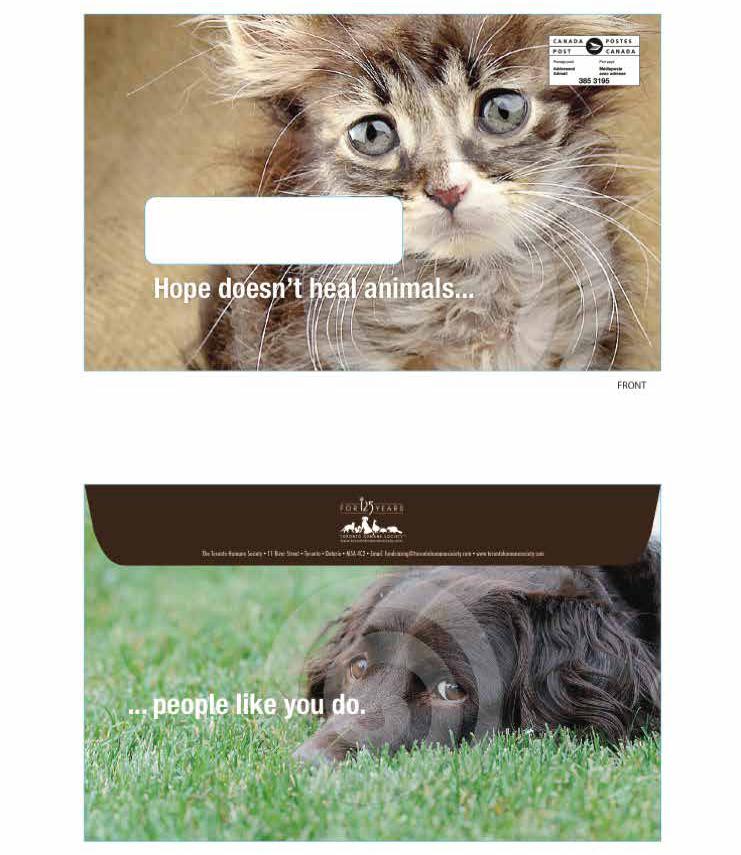
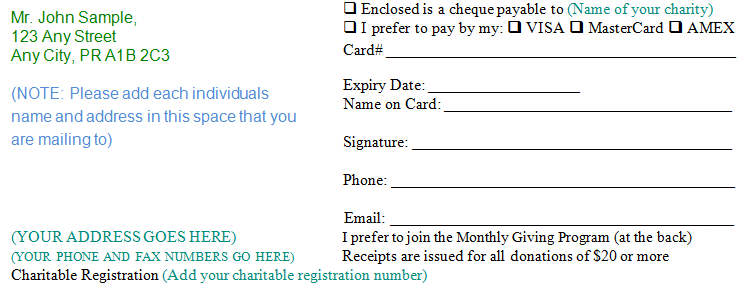
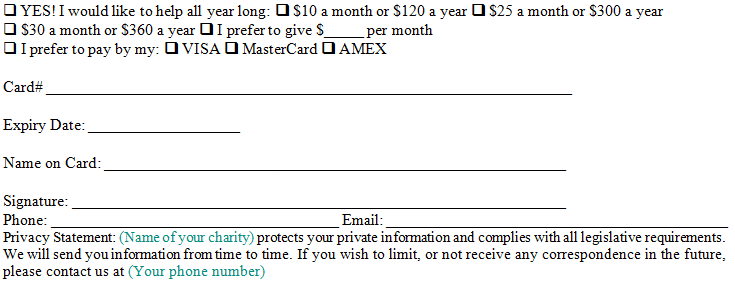


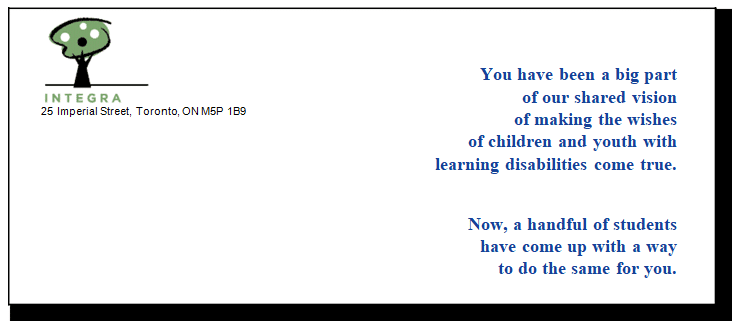
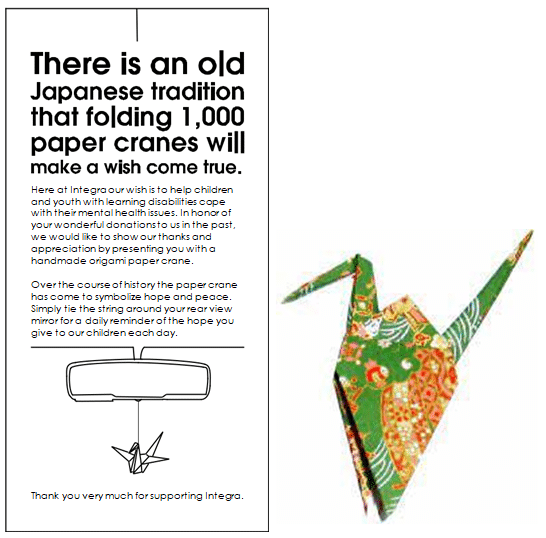
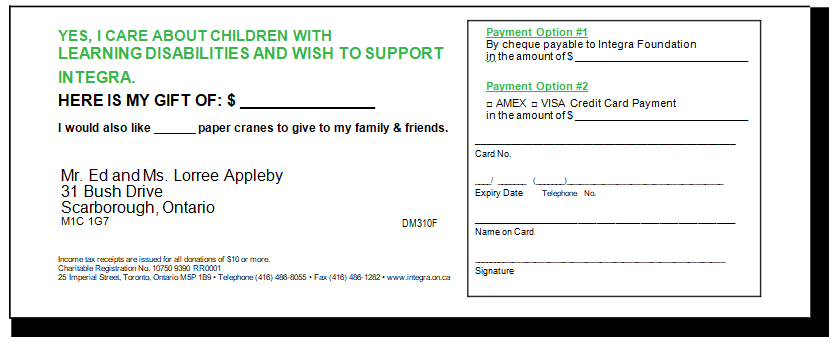
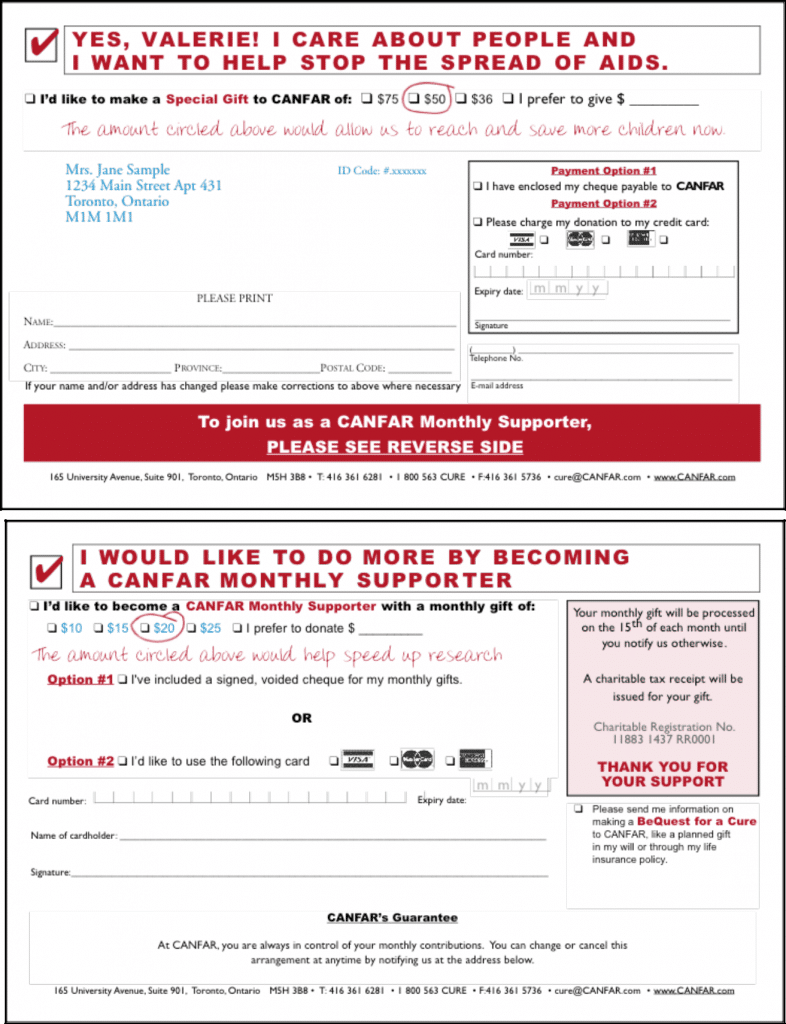
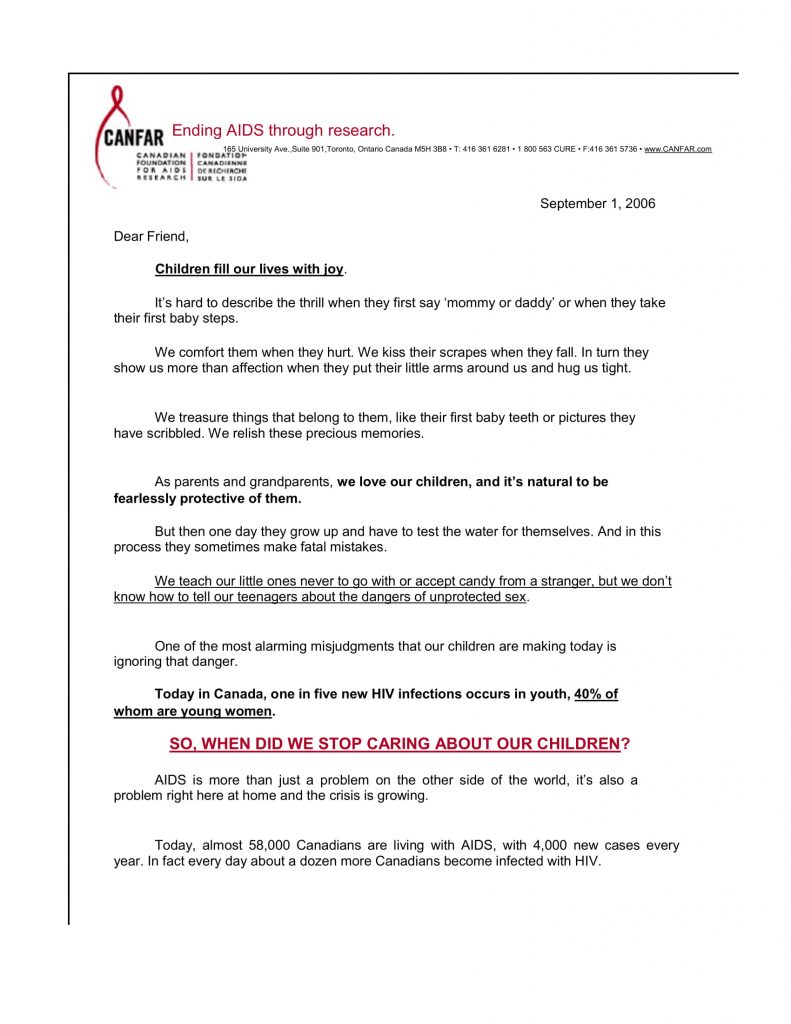
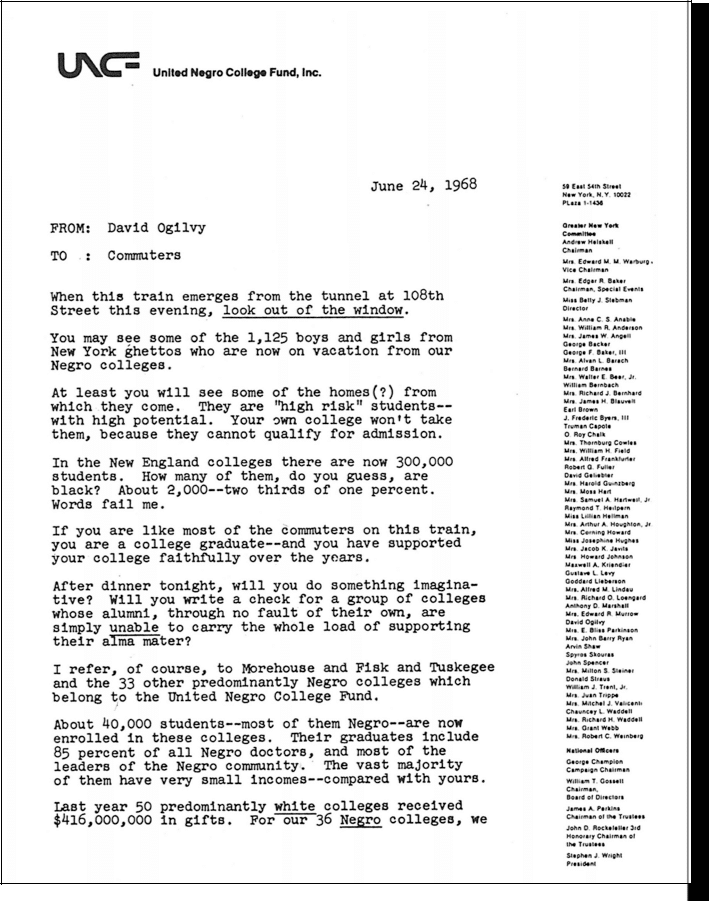
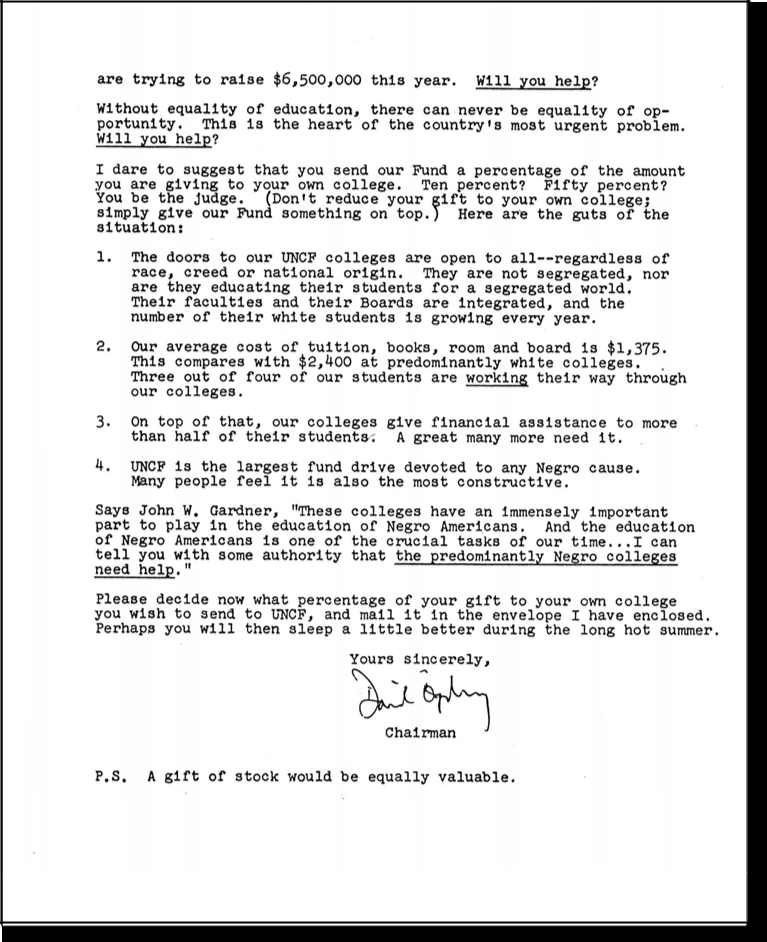
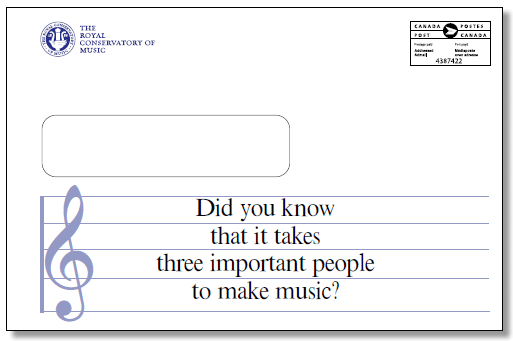
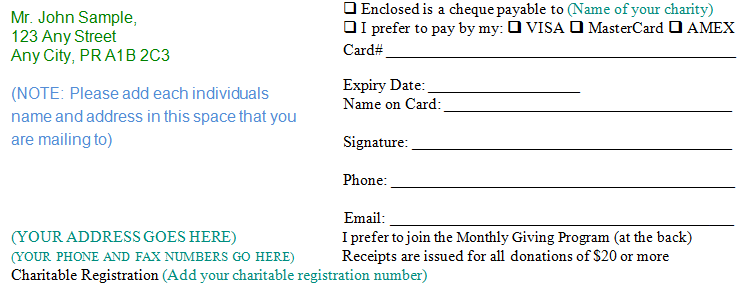
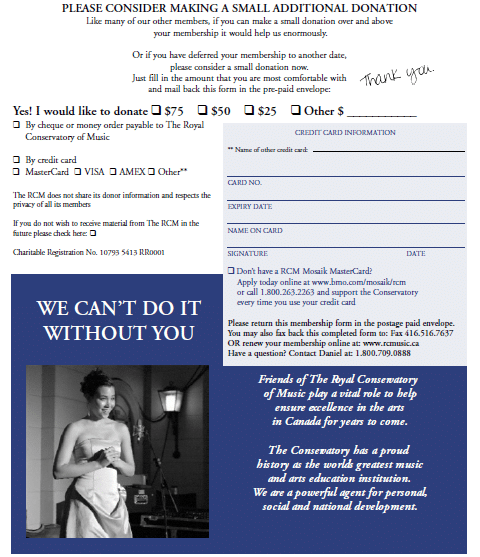
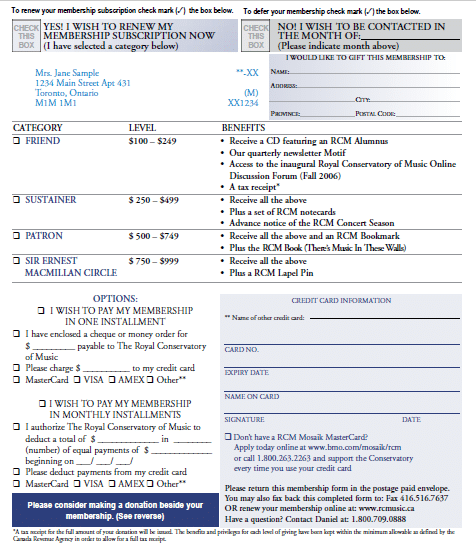
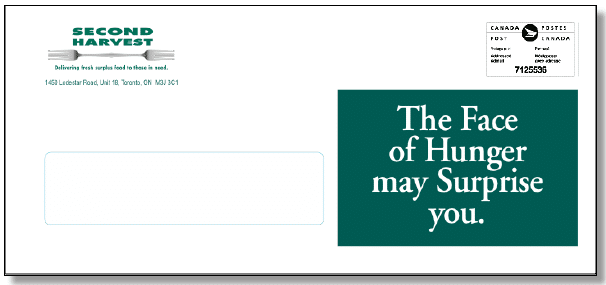
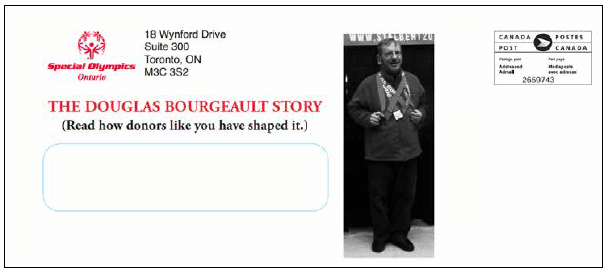
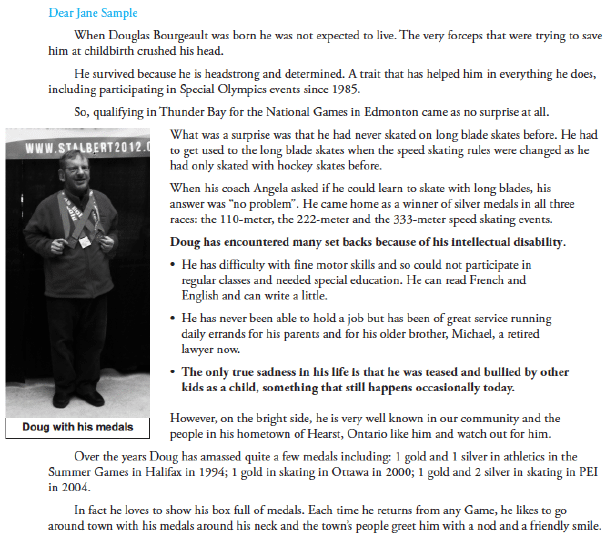


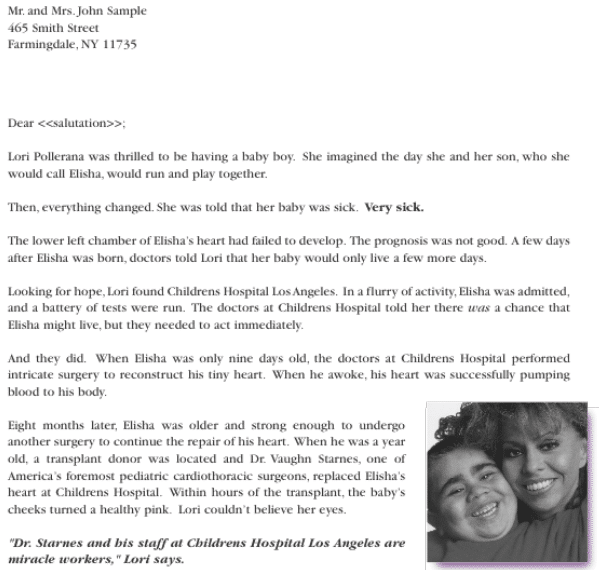
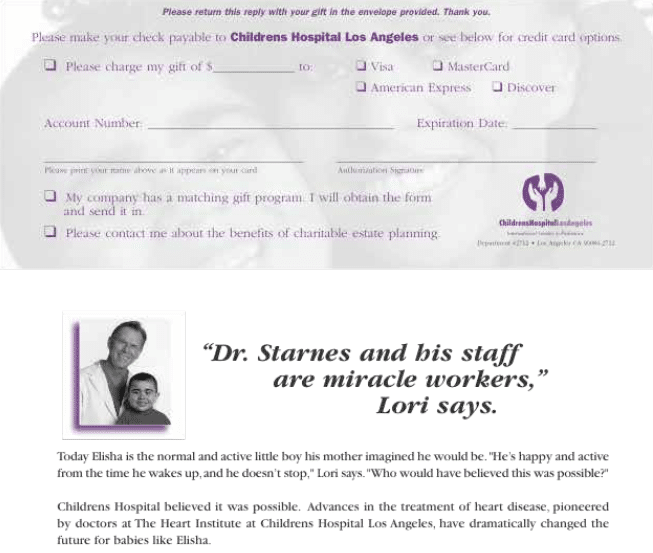
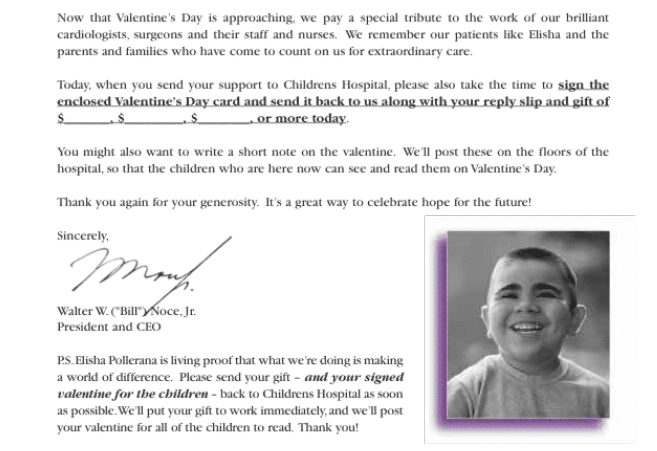


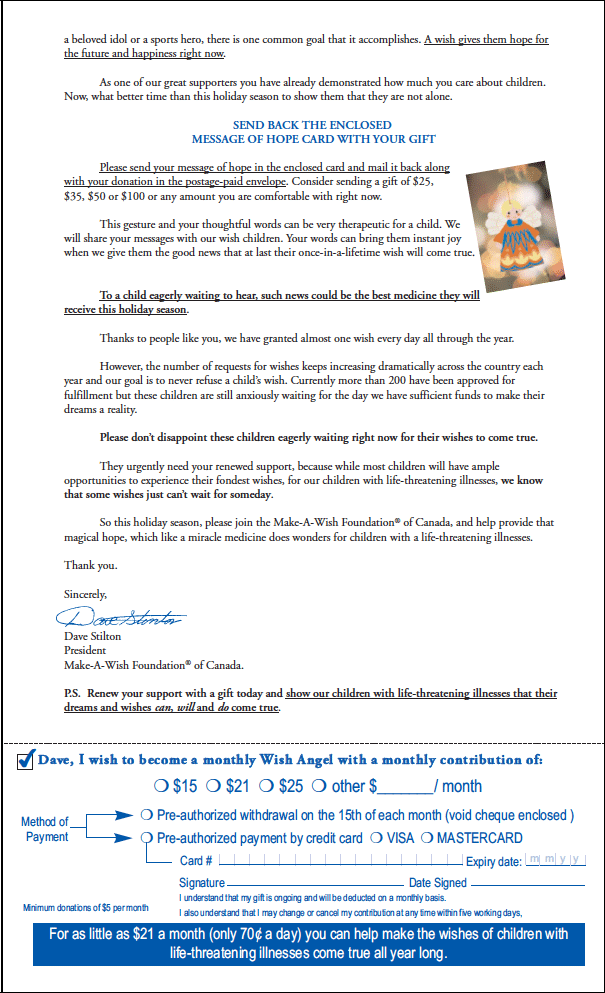

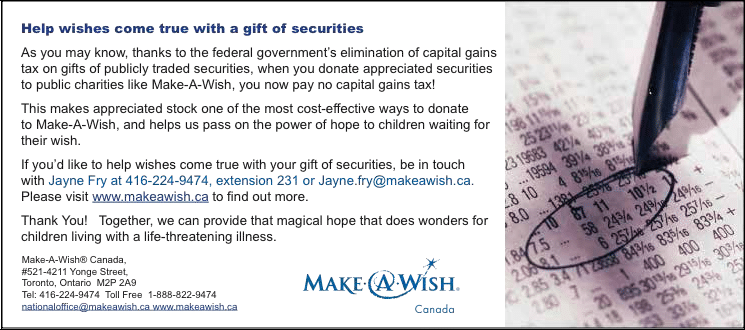
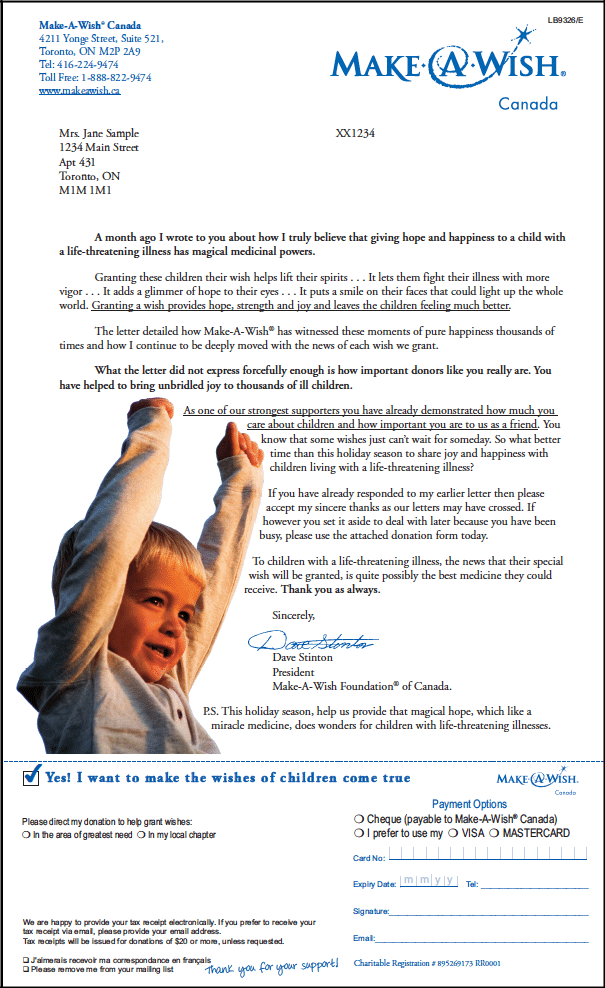
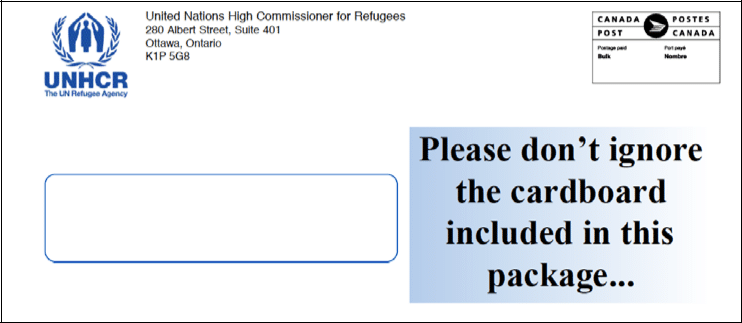
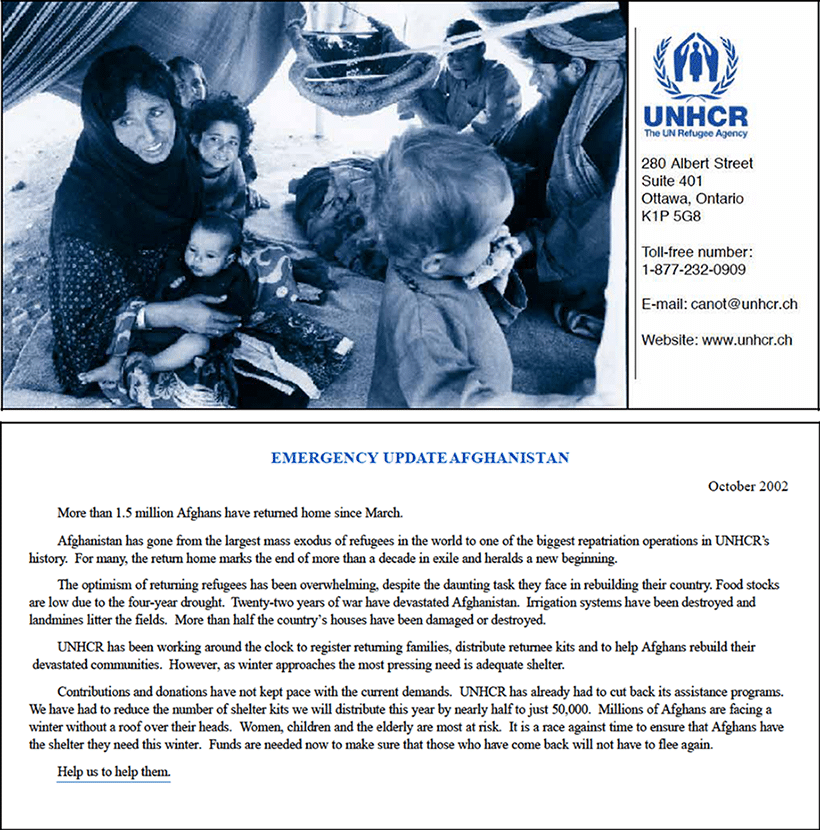

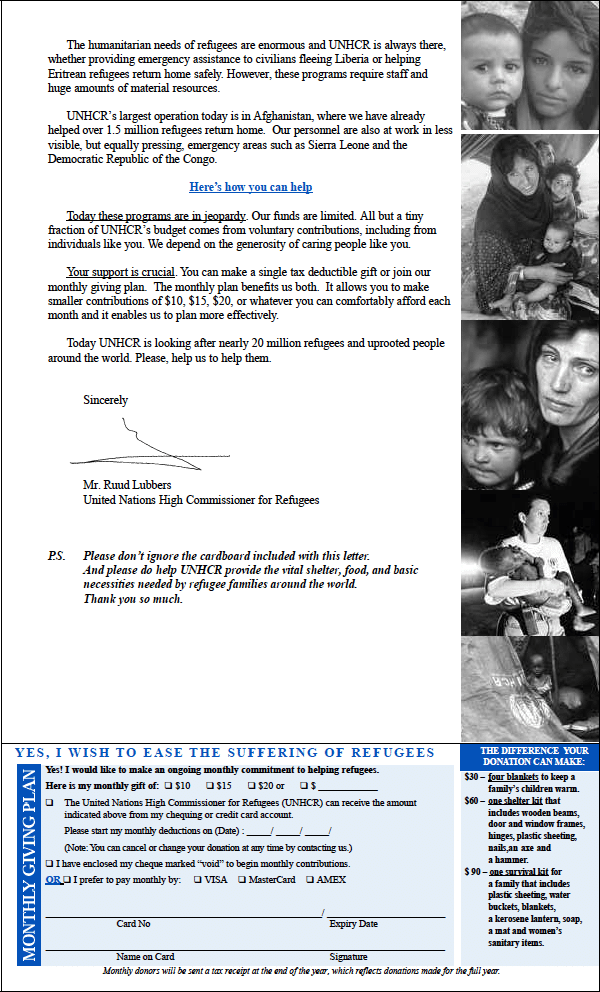


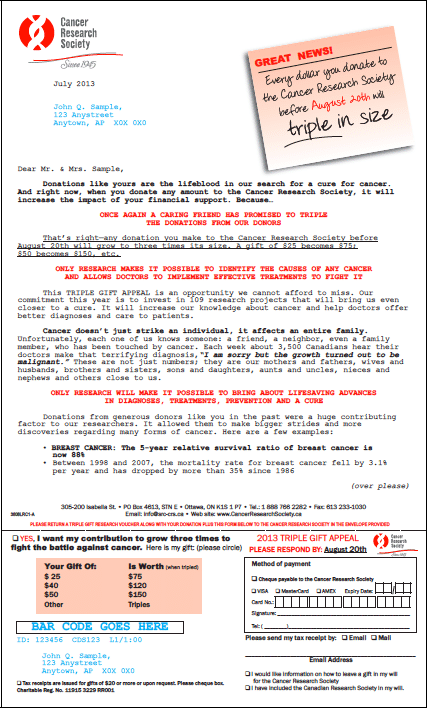
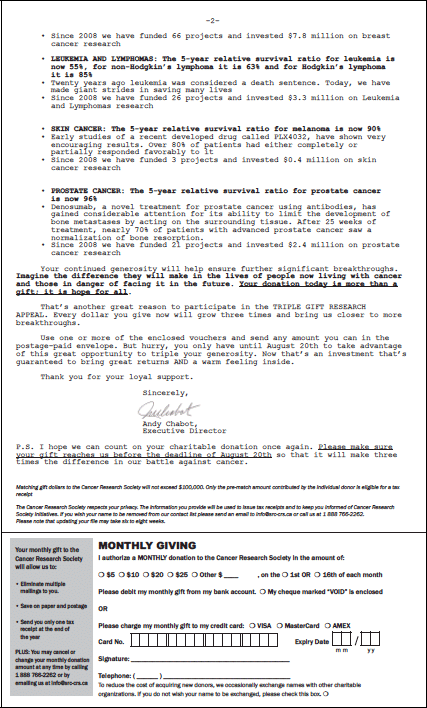
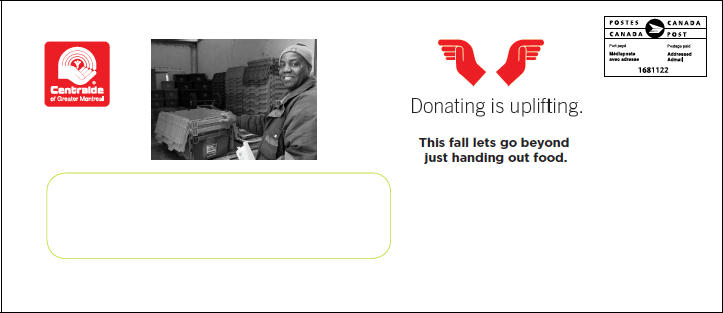
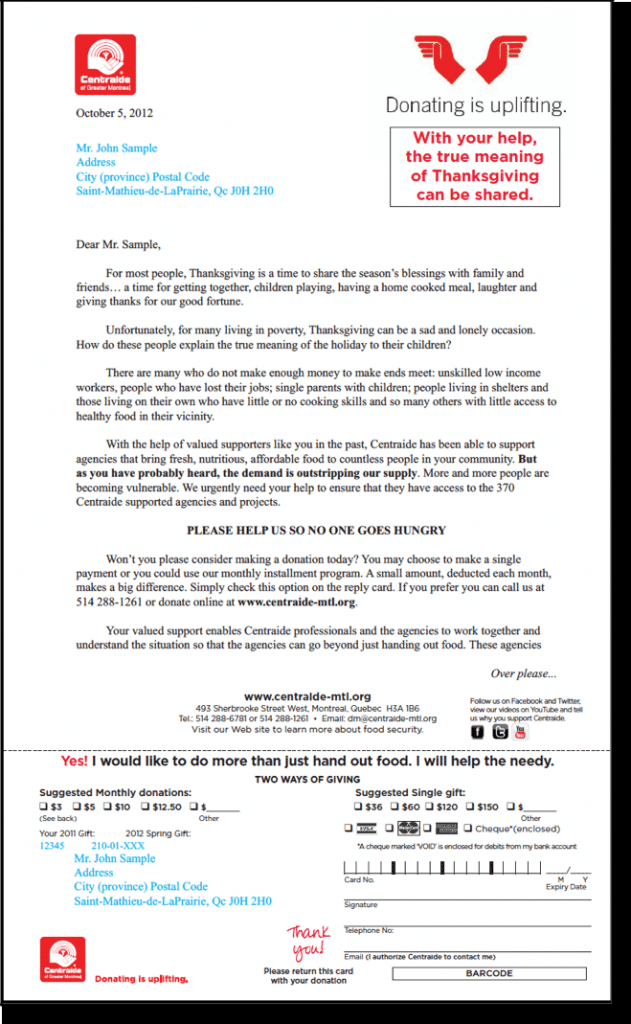
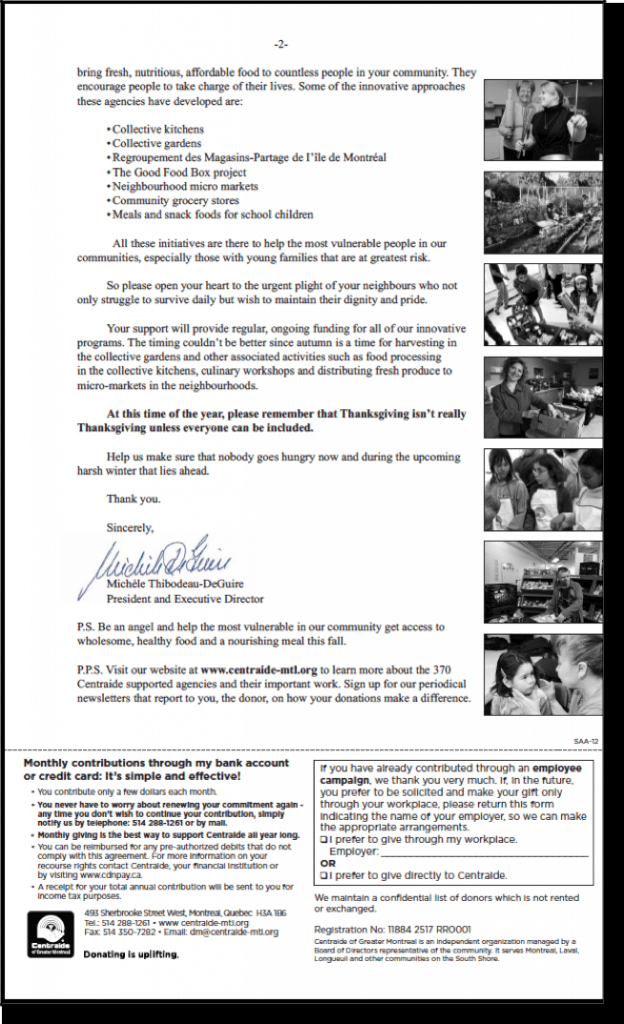
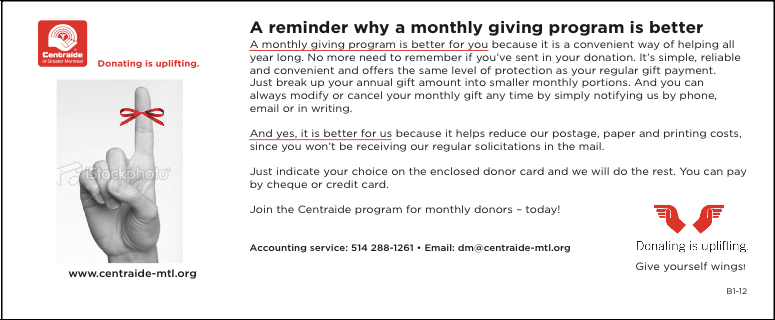
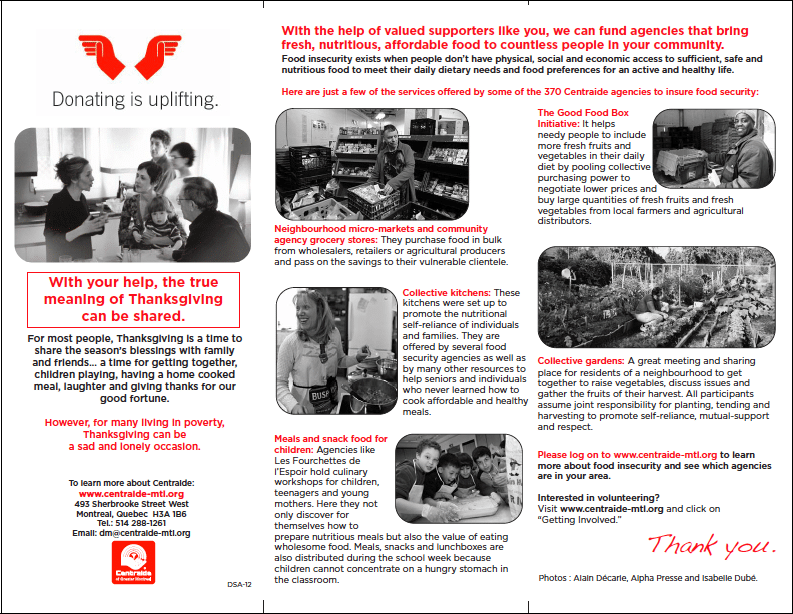

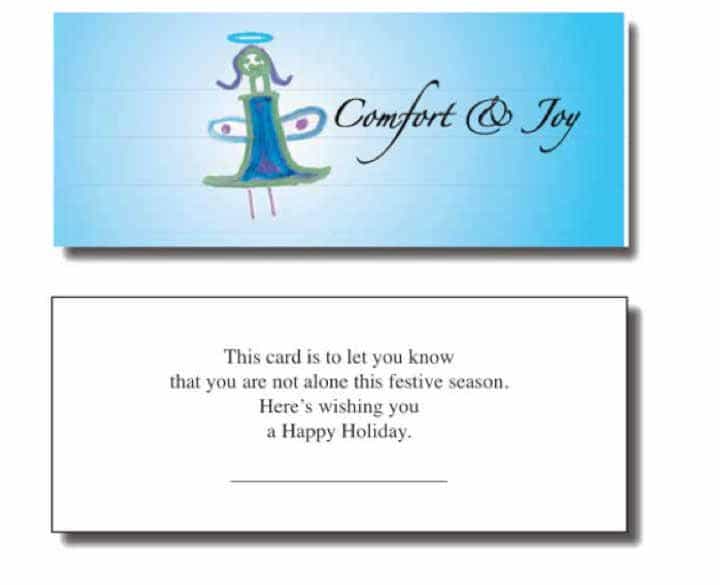
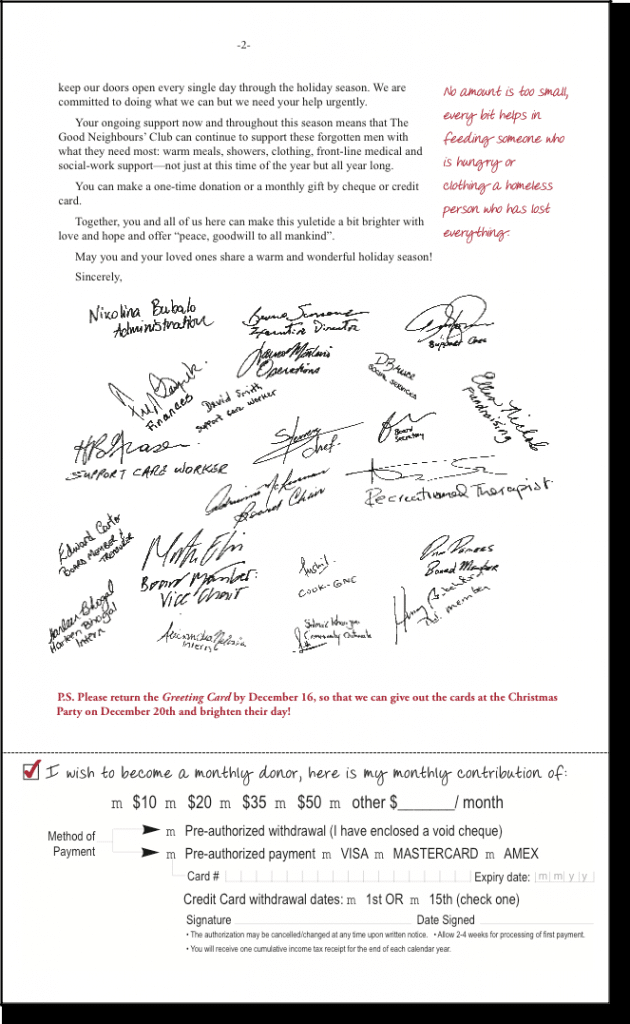

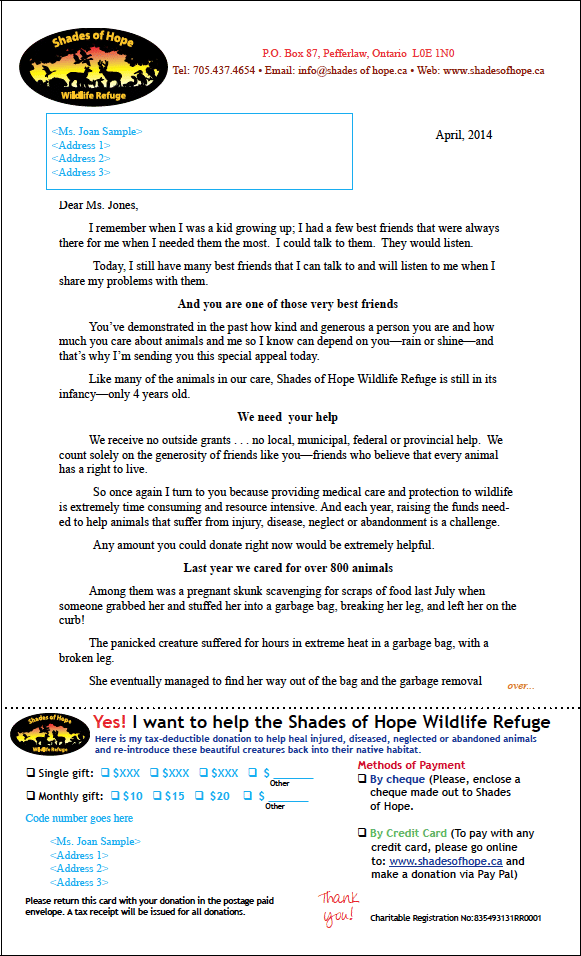
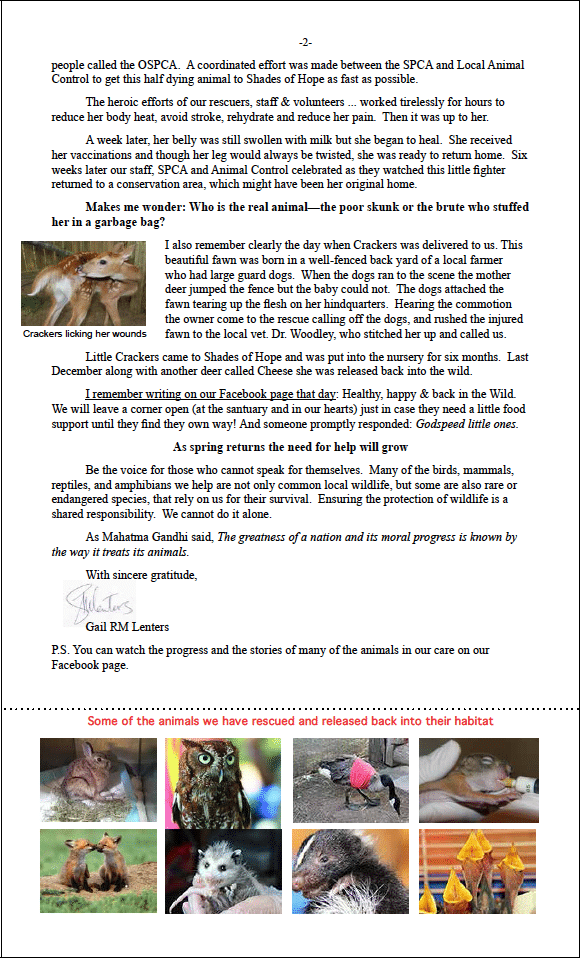
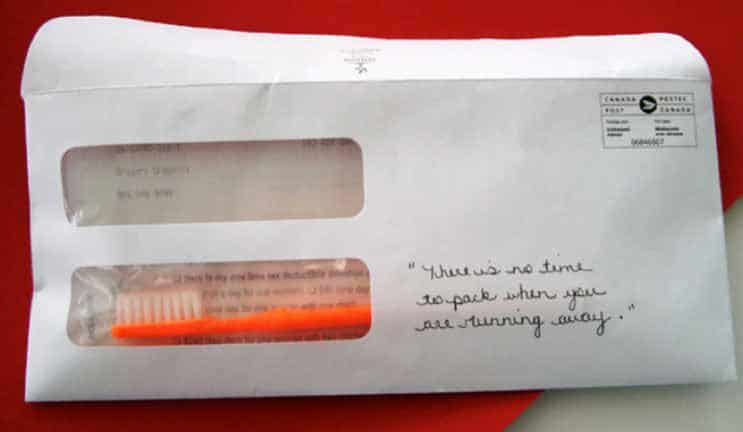
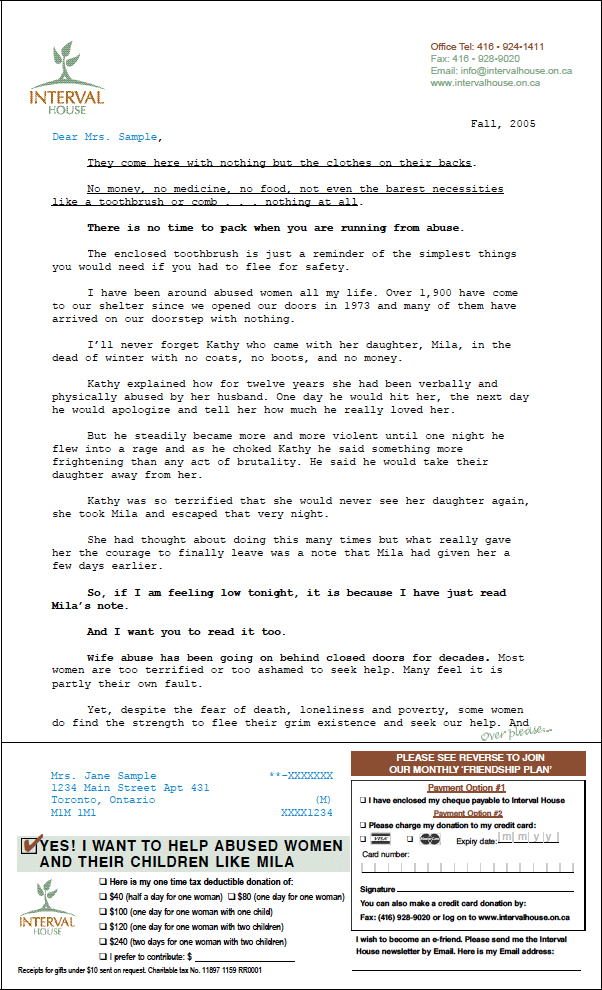
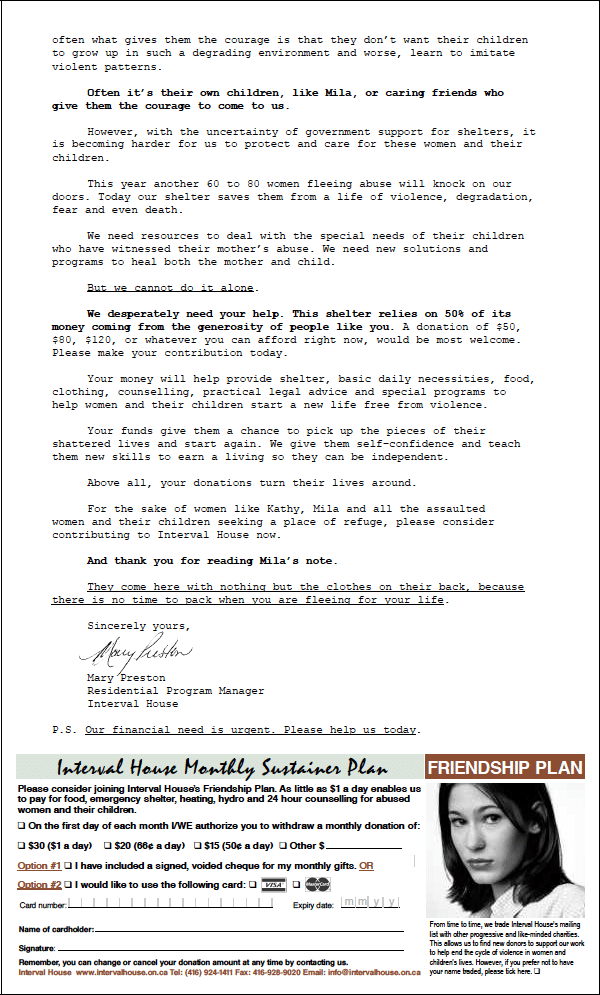
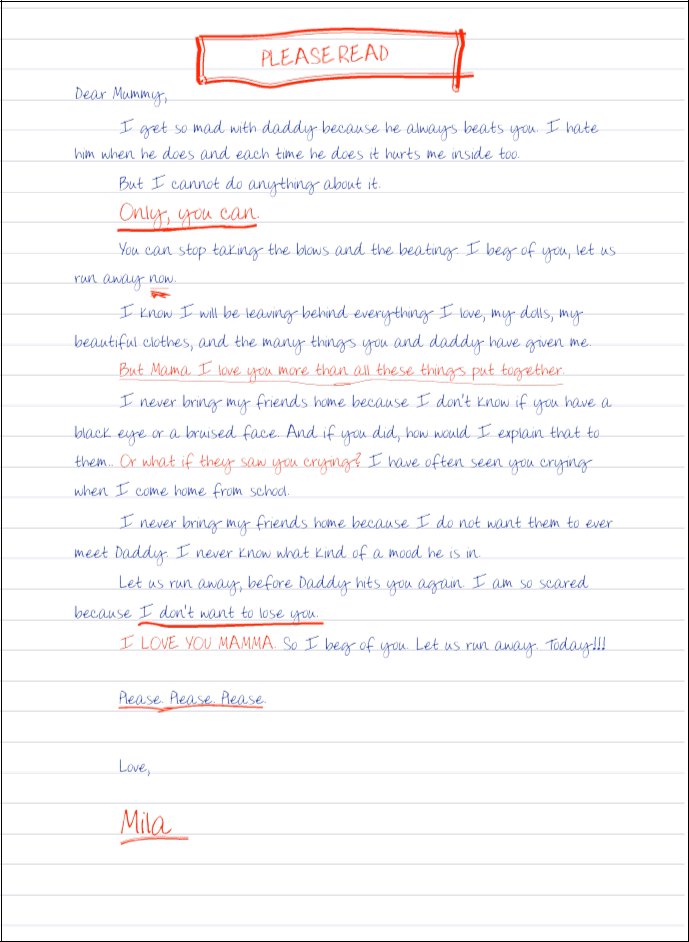
.png)